Your home fragrance blending station needs essential tools for safe, precise mixing. Start with amber glass bottles, droppers, and digital scales for accurate measurements. You'll want protective gear like gloves and goggles, plus proper ventilation in your workspace. Include scent strips, a fragrance wheel, and blending guides for reference. Don't forget cleaning supplies and storage solutions like a Lazy Susan. There's so much more to explore in creating your perfect setup.
Essential Oils and Fragrance Storage Solutions
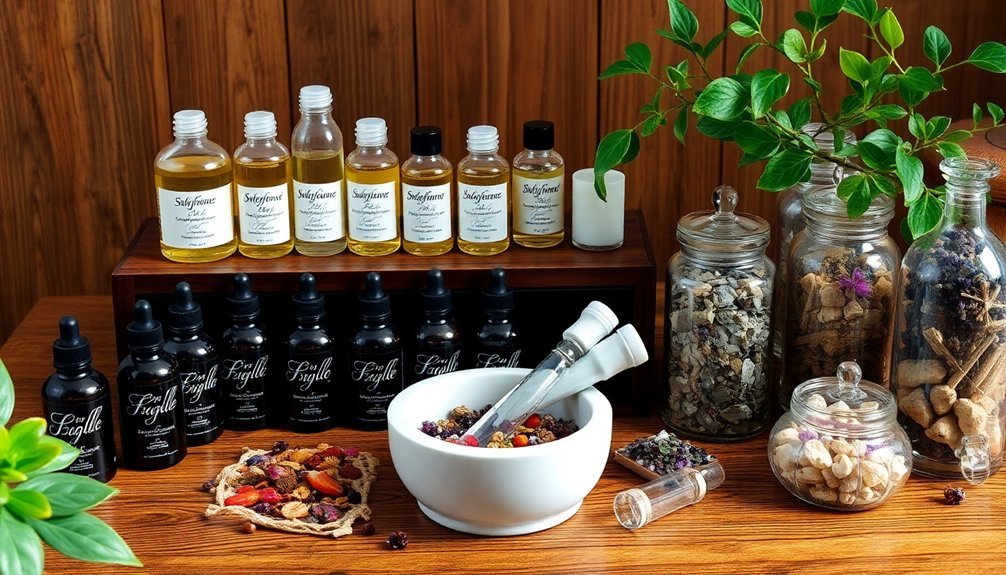
When setting up a home fragrance blending station, proper essential oil storage forms the foundation of your success.
You'll need to create a dedicated space that protects your oils from their biggest enemies: heat, light, and oxygen. Choose amber or cobalt blue glass bottles that shield your precious oils from damaging light exposure, and make certain they're tightly sealed to prevent oxidation.
Select a cool, dark location away from stoves, radiators, and windows for your storage area. You can maximize your space with practical solutions like Lazy Susans, medicine cabinets, or wooden boxes. Keep in mind that top and base notes will require different storage considerations based on their evaporation rates.
These options keep your oils organized, easily accessible, and protected. If you're working in a small space, consider a compact wooden storage box or a specially designed essential oil case that keeps bottles upright and secure.
Measuring Tools and Equipment Setup
Setting up your home fragrance blending station starts with selecting precision tools like droppers, pipettes, and digital scales to guarantee accurate measurements of your oils and fragrances.
You'll need a dedicated workspace equipped with glass containers and proper storage solutions to keep your materials organized and prevent cross-contamination.
Don't forget essential safety equipment, including protective gloves, goggles, and proper ventilation, to create a secure environment for your blending activities.
Having amber glass bottles on hand is crucial for protecting your essential oils and finished blends from degradation caused by sunlight exposure.
Precision Tools For Accuracy
Accurate measurements form the foundation of successful home fragrance blending. You'll need a precision scale that measures to at least three decimal places and includes a tare function for container weight adjustment.
While scales range from $20 to over $1,000, invest in a lab-grade option for reliable results. Brands like Ohaus and Kern offer professional-quality scales with excellent build and responsiveness.
To guarantee precision in your blending process, you'll want:
- A dedicated calculator for quick dilution calculations and formulation math
- Clean glass containers and pitchers specifically for fragrance work
- Various spatulas for handling solid materials and resins
- Test strips and holders for sampling and comparing scents
Keep these tools separate from your kitchen equipment to maintain purity and prevent cross-contamination.
Remember to label your containers clearly with contents and concentration levels for safety and organization.
Storage And Organization Systems
A well-organized blending station combines proper storage solutions with efficient equipment setup to guarantee your fragrance-making process runs smoothly.
You'll need to store your fragrances in cool, dark places away from direct sunlight and fluctuating temperatures. Skip the bathroom and opt for a vanity drawer, cabinet, or dedicated shelf in your bedroom.
For organization, consider using white tray displays, acrylic tiered organizers, or a rotating lazy Susan to keep your bottles accessible and visible.
Your measuring tools should include digital scales with tare functions, glass beakers, and disposable pipettes for precise measurements.
Keep your equipment clean and sterilized with soapy water and ethanol. Set up your station in a stable, well-lit area, and arrange bottles upright to prevent leakage.
Add personal touches with decorative elements if desired.
Essential Safety Equipment
Safe fragrance blending requires three essential categories of protective equipment: personal protection, measurement tools, and workspace safety items.
You'll need to prioritize accuracy and safety when setting up your measurement station.
- Always use a digital scale with precision to at least two decimal places, guaranteeing your fragrance ratios are exact.
- Select a glass pitcher or container specifically for measuring fragrance oils, as plastic may react with certain ingredients.
- Utilize your scale's tare function to eliminate container weight and achieve precise measurements.
- Measure by weight rather than volume, as oil densities can vary considerably.
Remember to keep your workspace clean, dry, and well-organized.
Having the right measurement tools not only guarantees consistency in your blends but also helps prevent costly mistakes and waste.
Workspace Safety and Ventilation Requirements
Creating a well-ventilated and secure workspace for fragrance blending requires careful consideration of safety protocols and proper equipment placement.
You'll need to set up your diffuser and blending equipment on a stable, elevated surface that's away from edges and high-traffic areas. Make certain you're working in a well-ventilated space to prevent concentrated aromas, but avoid placing equipment directly in airflow paths from vents or windows.
Position your workspace near appropriate power outlets, but keep all electrical components away from water sources.
When setting up your blending station, tuck away power cords to prevent tripping hazards and guarantee your equipment has enough clearance to operate safely.
Don't work in small, enclosed spaces – proper airflow is essential for both safety and effective fragrance dispersion.
Blending Guide Resources and Testing Materials
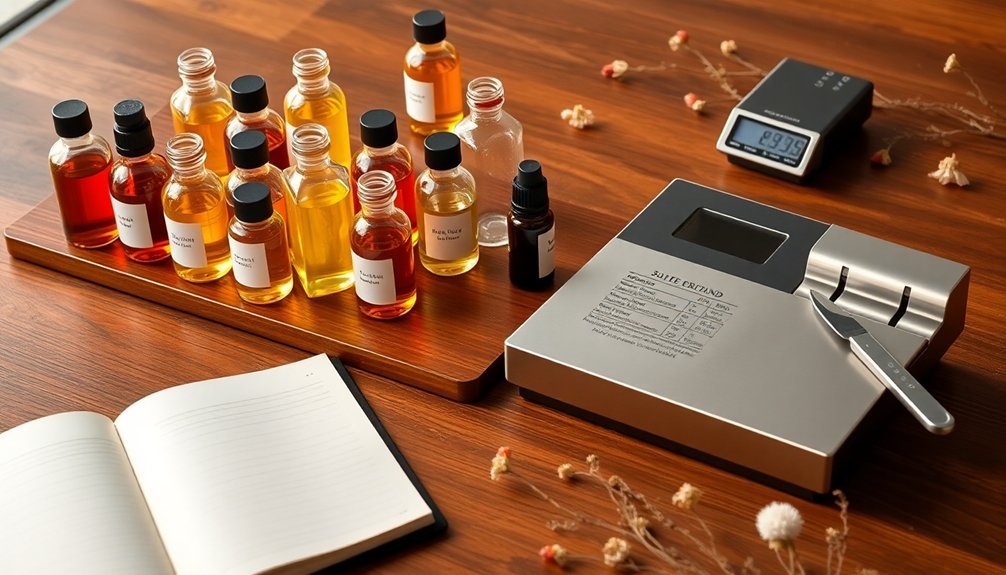
You'll need a core set of testing materials including pH-neutral scent strips, pipettes, and amber glass bottles to begin creating your fragrance blends.
Keep essential blending guides and fragrance wheels close at hand to understand how different scent families interact and complement each other.
Start building your reference library with extensive essential oil guides that detail therapeutic benefits and scent profiles, while maintaining detailed records of your blend ratios and combinations for future reference.
Essential Testing Materials Needed
Successful fragrance blending depends on having the right testing materials at your disposal.
You'll need amber glass bottles to protect your blends from light degradation and maintain their potency over time. Using pipettes guarantees accurate measurements when mixing oils, while test strips help you evaluate how fragrances develop.
- Keep cotton swabs handy to make small adjustments to your blends without wasting precious oils.
- Use coffee beans between testing to reset your sense of smell and prevent nose fatigue.
- Store clean pipettes nearby for precise measurements and consistent results.
- Keep test strips ready to track how your fragrances evolve over 30-60 minutes.
Remember to organize these materials in a clean, accessible workspace where you can easily reach them during the blending process.
Mastering Blending Reference Tools
With your testing materials ready, mastering the right reference tools will take your fragrance blending skills to the next level.
Start by acquiring a fragrance blending wheel, which works like a color wheel to help you identify complementary scents. You'll also need reference guides for fragrance families and note classifications (top, middle, and base) to create balanced blends.
Keep pre-tested blend recipes handy for inspiration, and consider watching blending workshops to expand your knowledge. These resources will help you understand proper ratios, like the 30-50-20 rule for top, middle, and base notes.
When starting out, stick to basic, familiar scents and follow step-by-step guides. As you gain confidence, you can adjust ratios and customize blends to match your preferences.
Digital Tools and Mixing Technology
Modern fragrance blending has evolved far beyond manual mixing, thanks to cutting-edge digital tools and advanced mixing technology.
You'll find that today's home blending stations seamlessly integrate smartphone apps with precise mixing systems for professional-level results.
- Use AI-powered apps to create custom fragrance profiles, adjust intensity, and set diffusion schedules through your mobile device or voice commands via Alexa and Google Assistant.
- Incorporate automated blending devices that use dry-air or nebulizing technology for pure, mess-free fragrance diffusion.
- Install a system compatible with multiple fragrance cartridges, offering up to 300 hours of coverage with phthalate-free, certified-safe scents.
- Set up ambient LED lighting and energy-efficient controls that let you manage both manual and digital aspects of your blending experience.
Cleaning and Maintenance Protocols
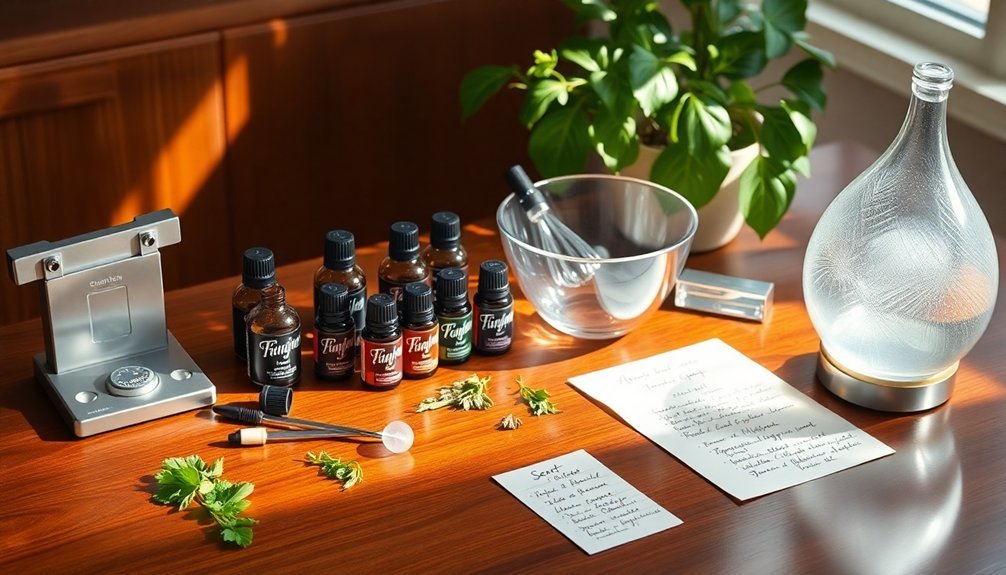
Maintaining a pristine home fragrance blending station requires consistent cleaning and careful attention to detail. You'll need to clean your diffusers regularly – every two months for daily use, or quarterly for occasional use. This prevents oil buildup and maintains peak performance.
| Task | Frequency | Tools Needed |
|---|---|---|
| Diffuser Cleaning | Bi-monthly/Quarterly | Cleaning solution, cloth |
| Bottle Sanitization | Between scents | Rubbing alcohol, dry cloth |
| Surface Wiping | Weekly | Damp cloth, mild cleaner |
Before cleaning, unplug your diffuser and empty the scent bottle. Fill it with a quarter inch of cleaning solution and run for 15-20 minutes. Wipe down the exterior with a damp cloth, and thoroughly dry all components before adding new fragrance oil. Your diffuser's ready for immediate use after proper cleaning.
Frequently Asked Questions
How Long Do Blended Fragrances Typically Remain Stable and Usable?
You'll find properly blended fragrances can stay stable for months to years when you store them correctly. Your blends need a cool, dark place, and they'll usually improve during the first week of maturation.
Can I Sell My Custom-Blended Fragrances to Others?
You'll need proper safety documentation, IFRA compliance, and business registration before selling custom fragrances. You must also have insurance coverage and follow local regulations for labeling and product safety.
What Temperature Should I Maintain in My Fragrance Blending Workspace?
You'll want to keep your workspace at normal room temperature (68-72°F/20-22°C). This comfortable range won't affect your fragrance oils during blending, as they're stable at room temperature for mixing purposes.
How Do I Properly Dispose of Failed Fragrance Blending Experiments?
You'll need to evaporate small amounts in a well-ventilated area, or take them to a hazardous waste facility. Don't pour oils down drains. Always wear protective gear and follow local disposal regulations.
Are There Specific Fragrance Combinations That Should Never Be Mixed Together?
You'll want to avoid mixing strong florals with intense oriental scents, and don't combine highly sweet with bitter notes. Also, stay away from blending fragrances of vastly different intensities without proper dilution.
In Summary
You're now equipped to create your own home fragrance blending station with proper storage, measuring tools, safety equipment, and essential resources. Keep your workspace organized, maintain good ventilation, and follow cleaning protocols to guarantee consistent quality. Whether you're using digital tools or traditional methods, you'll be ready to craft unique scents that transform your home into a personalized aromatic sanctuary.
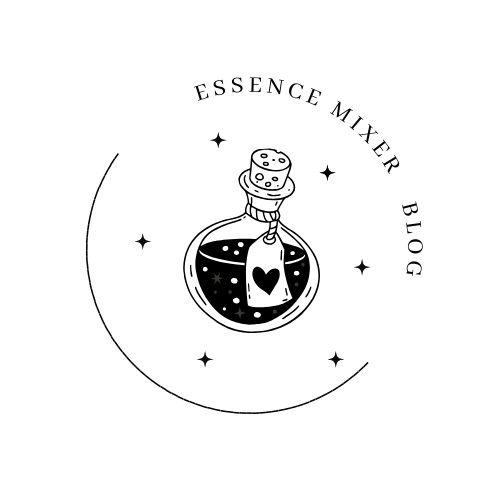
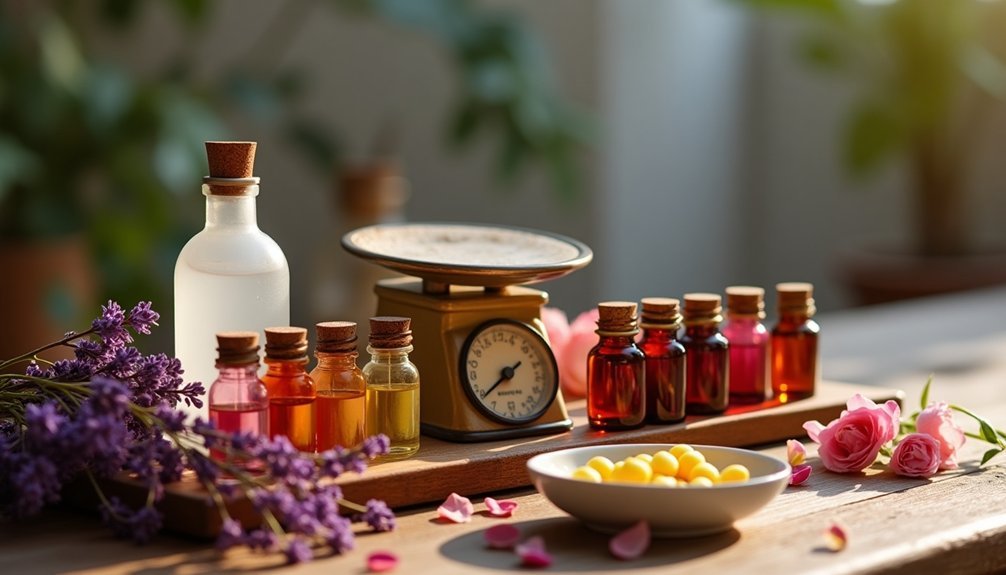



Leave a Reply